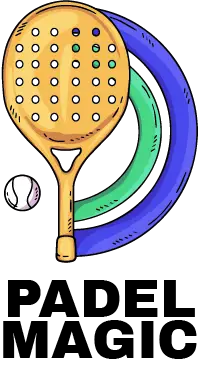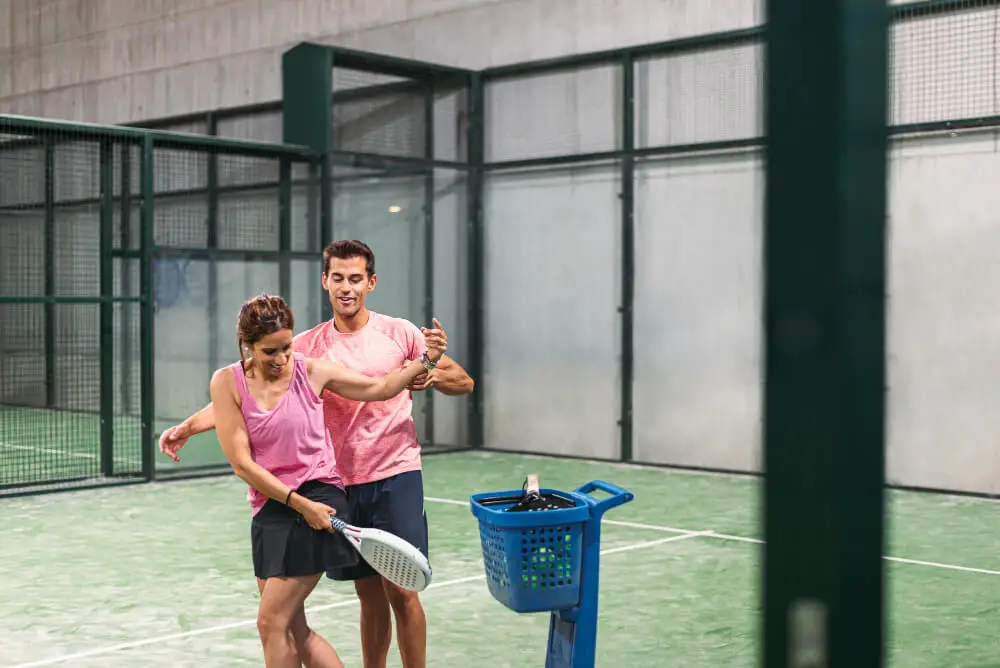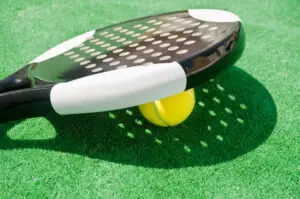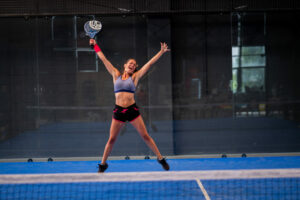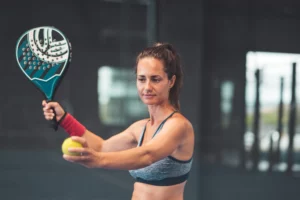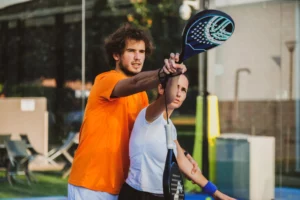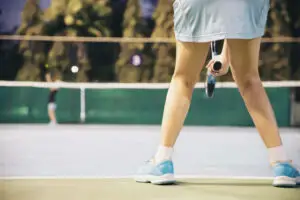Welcome to our focused guide on Padel Drills, perfect for players eager to improve their game. Here, you’ll find targeted exercises to sharpen your skills, from footwork to strategy, suitable for all levels of play.
Padel Tennis Drills: Improve Your Game with These Exercises
Padel tennis drills are essential to any Padel player’s training routine. By incorporating a variety of different drills into your practice sessions, you can improve your technique and tactical awareness, as well as develop the physical and mental skills needed to succeed in this fast-paced sport.
Padel tennis drills involve working on specific areas such as footwork, ball control, shot selection, and accuracy. This article will look at the most essential Padel drills you should incorporate into your training program to maximize your potential. We will discuss the importance of each drill, how it can help you become a better player, and how to effectively perform them on the court.
1 Up 1 Down
The ‘One Up, One Down’ drill is a dynamic exercise in Padel that focuses on enhancing both offensive and defensive skills. In this drill, one player positions themselves at the net (up) and the other at the back of the court (down).
This setup mimics actual game scenarios, where players often have to switch between attacking and defending quickly. The drill emphasizes coordination, communication, and quick decision-making as players work together to maintain a rally. It’s excellent for developing volley skills for the player at the net and groundstroke accuracy for the player at the back, ensuring a well-rounded improvement in overall gameplay.”
Cross Court
The ‘One Cross Court’ drill in Padel is designed to refine a player’s ability to handle and return cross-court shots, a fundamental aspect of the game. In this exercise, two players position themselves diagonally across from each other, each targeting their shots to the opponent’s cross-court area.
This drill improves accuracy and control and enhances a player’s anticipation and footwork, as they must consistently move and adjust to return the ball effectively. Ideal for players looking to improve their rally consistency and court coverage, ‘One Cross Court’ offers a focused way to practice one of Padel’s most common and crucial shot types.
1 Down 1 Up
The ‘1 Down 1 Up’ drill in Padel is a strategic exercise that helps players develop their court positioning and teamwork.
In this drill, one player stays at the baseline (‘1 Down’), focusing on long-range shots and defense, while their partner positions themselves near the net (‘1 Up’), ready to volley and attack. This arrangement mimics typical gameplay, where players often switch between offensive and defensive roles.
The drill reinforces the importance of communication, as the players must coordinate their movements and shots effectively. It’s an excellent way for players to enhance their adaptability, understanding of court dynamics, and ability to transition between different play styles seamlessly.
Four Ball Drill
The ‘Four Ball Drill’ in Padel is a comprehensive exercise designed to enhance a player’s overall game by focusing on various shot types and court movements. In this drill, players practice four shots in succession – a forehand, backhand, volley, and lob – either with a partner or against a wall.
This sequence challenges players to adjust their positioning and technique for each shot type, improving their agility and versatility on the court. The drill is particularly effective for developing consistency across all the fundamental strokes, as well as for honing quick decision-making skills. Whether for warming up or skill enhancement, the ‘Four-Ball Drill’ offers a balanced approach to mastering the essentials of Padel.
Groundstroke Padel Drills
Groundstroke Padel drills are an important part of any Padel tennis training program, as they provide players with the opportunity to develop their technique and power in strokes such as forehands and backhands.
These drills focus on refining stroke mechanics while also developing accuracy, consistency, and control over the ball. Groundstroke drills can be performed either alone or with a partner, depending on what type of drill you choose to do.
Volley Padel Drills
Volley drills are essential for any padel player, as the volleying game is one of the most important elements in a successful match. Volleys are fast-paced shots that require quick reflexes and precise accuracy. Therefore, it is important to include volleys into your training routine to develop these skills and refine your technique. Volley drills involve working on specific aspects such as footwork, body position, balance, and timing.
Serve and Return Padel Drills
Serve and return drills focus on refining your technique while also developing power, accuracy, and control over the ball. Various drills can be practiced to improve the serve and return skills in padel. Here are some examples:
- Target practice – have a partner feed you balls from different positions around the court while you hit them toward specific targets (e.g. corner of the court). This drill helps to refine your aim when serving or returning a shot.
- Cross-court challenge – one player stands at the net while another feeds the ball cross-court with varying spin and trajectory. The goal of this drill is to work on your reaction time and accuracy when returning a serve or volley.
- Serve to serve – practice alternating between different types of serves (e.g. flat, slice, topspin, etc.) while focusing on technique, power, and accuracy.
- Serve and Lob Drill – in this drill, the serving player practices serving and immediately hits a lob to the back of the court. The objective is to surprise the opponent and force them to hit a defensive shot, allowing the serving player to take control of the point.
- Return of Serve Drill – in this drill, one player serves the ball, and the other player practices returning the serve. The objective is to return the serve in a way that makes it difficult for the serving player to attack or place the ball in a favorable position.
These drills can be practiced alone or with a partner and can help improve the serve and return skills in padel. It is important to focus on technique, accuracy, and consistency to develop a well-rounded game.
Fitness Drills
Padel tennis is an intense sport that requires players to have excellent physical fitness and endurance to perform at their best on the court. Therefore, it is important to include fitness drills in your training program to improve your performance and reduce the risk of injury. Fitness drills focus on developing speed, agility, coordination as well as overall physical strength.
Examples of fitness drills include:
- Interval sprints – practice short sprints with rest intervals in between each sprint. This helps to increase speed and power while also developing cardiovascular endurance.
- Agility ladder – run through an agility ladder while focusing on quick feet and precise movements. This drill is excellent for improving footwork and coordination.
- Weighted carries – carry weights or kettlebells to increase muscular strength, cardiovascular endurance, and core stability.
- Jump squats – practice jump squats with or without added weights to improve lower body power and explosiveness on the court.
Incorporating drills into your training program is essential for any Padel player who wants to improve their game. The drills discussed in this article are just some of the many that can be practiced to develop technique, accuracy, speed, and agility.
Frequently Asked Questions
How do you train for padel?
Training for padel involves a combination of drills, practice matches, and physical conditioning. Focus on drills that improve shot accuracy, court movement, and strategy. Play practice matches to apply these skills in game-like situations. Incorporate strength and endurance training, as well as agility and flexibility exercises, to enhance your physical fitness for the demands of padel.
How can I improve my padel?
\Improving in padel requires practice, strategic learning, and physical fitness. Work on your shot precision, tactical play, and court positioning. Study and learn from advanced players or consider coaching for targeted advice. Regularly play matches to test and refine your skills under various scenarios. Additionally, maintain a strong fitness regimen to improve your agility, strength, and endurance.
How do you practice padel alone?
Practicing padel alone can be effective with specific exercises and drills. Use a wall to practice shots and improve your precision, consistency, and reaction time. Focus on forehand and backhand strokes, volleys, and serves. Work on your footwork and movement around the court. You can also perform physical fitness routines tailored to padel to enhance your agility, speed, and endurance.
